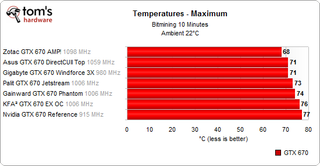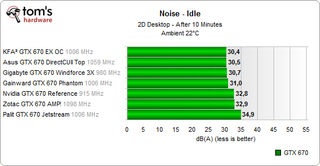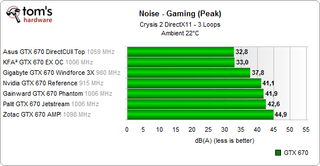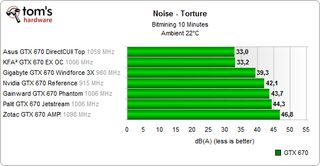Seven GeForce GTX 670 Cards, Benchmarked And Reviewed
We have seven GeForce GTX 670 cards. Which is fastest? Which is quietest? Each one swaggers onto the scene ready to prove its worth to your wallet. We emphasize thermals, acoustics, and design in this many-way shoot-out based on Nvidia's capable GK104.
Sound Level And Temperature: Stock Settings
Temperatures
We begin by measuring the operating temperatures of our seven GeForce GTX 670s at their factory clock settings. On the next page, we also report thermal conditions at an overclocked setting to give enthusiasts an idea of how these cards' coolers perform.




At idle, Zotac and Gigabyte achieve the lowest temperatures. Under full load and in the gaming benchmark, Zotac assumes the lead, a feat that is unfortunately accompanied by a significant sound level.
Sound Level
Speaking of acoustics, the Galaxy/KFA² card idles a little warmer than the other contenders at 38°C, but is able to run its fan very slowly as a result, generating no perceivable noise. Under load, its temperature is just a little higher than Nvidia's reference card. Its noise level appears to be similar to Asus' board, though it suffers from an extremely annoying high-frequency coil chirp. We contacted Galaxy/KFA² about this issue, which may be just a problem isolated to our test sample. A GeForce GTX 680 from the same manufacturer was louder overall, but lacked the chirping issue.
Also under full load, Gigabyte's card winds up louder than Asus and Galaxy/KFA², but still falls below the 40 dB(A) mark.



One more thing we'd like to mention is cooling on the DC-DC converters. It seems that nearly all add-in board vendors focus their cooling efforts on the GPU and somewhat neglect the power circuitry. Granted, the DC-DC converters of heavily-overclocked cards rarely exceed 100°C. But even temperatures around 95°C don't inspire a ton of confidence about a card's longevity. Enthusiasts willing to increase their card's core voltage will also want to keep this in mind.
Stay on the Cutting Edge
Join the experts who read Tom's Hardware for the inside track on enthusiast PC tech news — and have for over 25 years. We'll send breaking news and in-depth reviews of CPUs, GPUs, AI, maker hardware and more straight to your inbox.
The Zotac and Gigabyte cards exhibited the lowest temperatures on their voltage regulation circuitry, which may or may not affect your buying decision. In general, the models based on Nvidia's longer GeForce GTX 680-style PCB fare the best, possibly because they have more room for an optimized layout, or maybe because they employ the 680's DC-DC converter components.
Current page: Sound Level And Temperature: Stock Settings
Prev Page Benchmark Results: 3DMark 11 And Crysis 2 (DX 11) Next Page Sound Level And Temperature: Overclocked-
user 18 On the Gigabyte card's page:Reply
During the course of our testing, we effortlessly set this card to run at 1059 MHz, so we're not sure why Gigabyte held back so much. During testing, we overclocked this card to 1059 MHz quite easily, so we are somewhat surprised by the conservative factory overclock.
This seems to be saying the same thing twice. Error, or am I missing something? -
FormatC Reply
The roundup was published in German on May 22, 2012:10445301 said:Where is the msi gtx 670 power edition?
http://www.tomshardware.de/Nvidia-Geforce-GTX-670-Roundup,testberichte-241027.html
Sorry, but at this time (and 4 weeks later too) MSI was unable to deliver one of this cards. When MSI starts so late with this cards, then this is not our fault. ;)
-
user 18 Also, the second chart on the 'Sound Level and Temperature: Overclocked' page is missing the 'Mhz' label on the speed for the Palit card. It should read '1059 Mhz', while it reads only '1059'.Reply -
LonelyMan I'd like to see one for the 680s too, in which the 680 classified and lightning will be present, including others. :DReply
Most Popular

